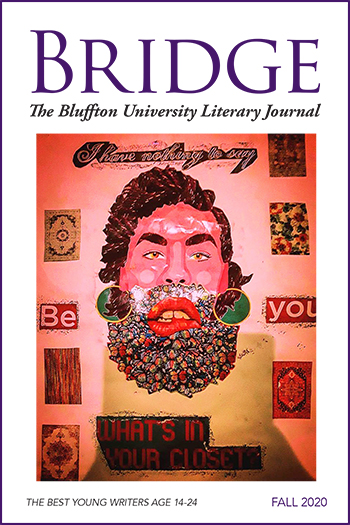
Bridge: Fall 2020

Bridge: The Bluffton University Literary Journal publishes twice a year, by the Bluffton University English Department, with one print edition and one online edition.
Members of the Bridge 2020 editorial staff selected the best artistic works representing young artists from across the country and the globe for the fourth annual fall online issue.
Editor Melissa Michal Slocum wrote:
“Our fiction choices became a semblance of future brokenness pushing and pulling together,
no matter the end. The lyric forms and lines in the non-fiction essays shape and fragment
and braid our own inner connections and disconnections, while the poetry explores
defining beauty and difficult choices. Finally, the drama piece merges all of these
braids and commonalities together through the destruction of memory, which only serves
to strengthen family, rather than tear the bond apart.”
Full editor's statement >
Fall 2020 Bridge
The Bluffton University Literary Journal
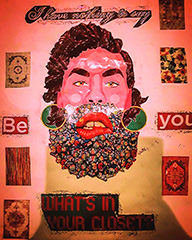 |
Graphic art BE YOU Je'Jae Daniels “In a world that the status quo is conformity, which we all partake in for a sense of safety and to avoid judgment, it's humorous to hear time to time from a few of my own supporters to express myself in any way which makes me happy, when in fact I fear the cost it takes to be standing on my own, sometimes alone. ” PDF > |
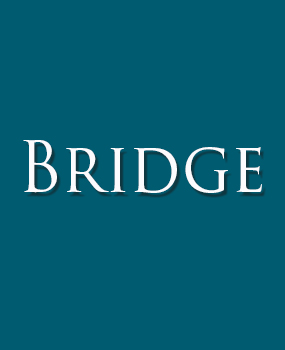 |
Fiction Nocturnal Grace Timko Dark, harrowing images and ambiguity build tension between the child, her father, and the meaning behind the crows and bats. The ominous tone in the story weaves readers through her traumas. PDF > |
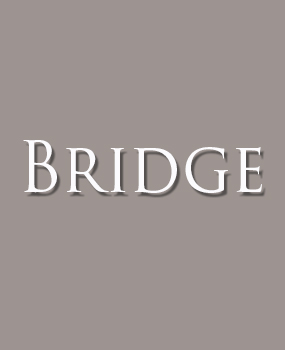 |
Poetry decorating the dearly departed Elizabeth Barrett “When the sun goes down I lie and wonder if one day, if my body goes still, she will put flowers in my teeth and hair, or if she will recoil in fear, shrieking at the sight of the end.” PDF > |
 |
Nonfiction The Girl in the Plastic Zoe Thomas Using the metaphor of a driver’s license to explore identity and familial relationships, the character development then transforms the driver’s license from something that is shameful to something that is reflective following the decreasing health of the narrator’s father. Overall, it is the tension between the two tones that allows the piece to explore these themes. PDF > |
 |
Poetry Stolen Sisters Amanda Conover “Stolen Sisters is a human rights movement advocating for Murdered and Missing Indigenous Women. In Canada and the U.S., Indigenous women are far more likely to be victims of violence and murder, which this movement aims to bring awareness to and to stop. ” PDF > |
 |
Poetry Aubade in the Inner City: 1973 Raki Jordan “I lay awake and watched the twinkling of light come twirling past the dirty glass of the window, and witnessed how it danced across the complexion of your skin.” PDF > |
 |
Fiction The Silent Hour Ahlana Hirschfield Haunting language and descriptions develop characters with high tension evoking dystopian waves of horror. This genre provides an important contrast between the characters’ desires and their lived abuse. PDF > |
 |
Poetry Three poems by Erik Porter She Teaches Me Palm Reading Shakespear’s Birds It Won’t Be Long Until the Sun Sets PDF > |
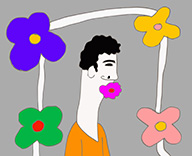 |
Art The flower boy Anthony A Nze PDF > |
 |
Poetry Flowercuts Jaewon Chang “Within a forest, magnolia trees create a shelter, the trail of petals form a pink carpet, a great hall without its top to envelope voices,” |
 |
Nonfiction To the Boy Who Painted His Face Brown with Mud to Match Mine Elyse Thomas The tension and honesty between the narrator’s childhood innocence and her present knowledge is illuminated through the stories of their interracial friendship and the moments of reflection that come after. PDF > |
 |
Poetry Sharing Oranges Hugh Cook If tomorrow there is dancing, Then today I can eat fire fried rice, PDF > |
 |
Fiction The Vessel Wong Wei Cong The vivid images and descriptions produce a somber tone that aids to the theme of loss. There is the loss of place and the loss of family that haunts both the character and us. Overall, this story creates a haunting tale full of vivid images and somber descriptions that tell of the loss the main character is feeling. PDF > |
 |
Nonfiction To Remember Even This Morgan Stevens We were captivated by the braiding form in this lyric non-fiction essay. The weaving of several subjects, such as the narrator’s relationship with her father, her mother, her desire to be an O.B.G.Y.N., and her tattoos, all braid in and out to form an exploration of the narrator’s body. By exploring what her body means to her, the narrator is in turn, discovering her identity. PDF > |
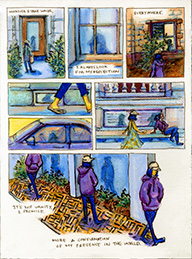 |
Comics Reflecting on Reflections Angie Kang PDF > |
 |
Fiction Motel 6 Sonja Henze This story focuses on themes such as racial injustice, poverty, finding one’s identity, and what it means to care about someone. The strong, tight language transmits the pain someone can feel when they are placed in a position of financial struggle. PDF > |
 |
Poetry Girl Talk Bridget Van Houtem “A bottle of red nail polish for me and a pale purple one for you” PDF > |
 |
Poetry The Fruit Omair Hasan “There was nothing wrong with the fruit. The act of eating a piece of heaven, holding the firm flesh of fruit” PDF > |
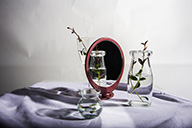 |
Art Still Life Emily Lu PDF > |
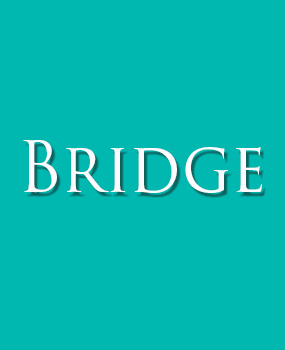 |
Drama In Memor(y)am Brooke Daly This play focuses on the important theme of mental health by creating tension between the husband, who suffers from dementia, and the wife, who is the primary caretaker of the husband. The grief that is felt by the wife from the loss of her daughter is portrayed in the language the author uses and tension created by the dialogue, the gaps in dialogue, and the pacing of the play. PDF > |
 |
Fiction Hope’s Flame Adina Edelman This story crafts a universal message using tight language and a metaphor that was unique to the situation. The dialogue found in the story contributes greatly to the pacing and intriguing plot by providing context, background, and tension. PDF > |
We accept fiction, nonfiction, drama, poetry, artwork, comics, graphic novels and slam poetry. If you are age 14-24 and are interested in submitting your work for consideration, please do so at https://bridgebluffton.submittable.com/submit
Copyright © 2020, Bridge: The Bluffton University Literary Journal